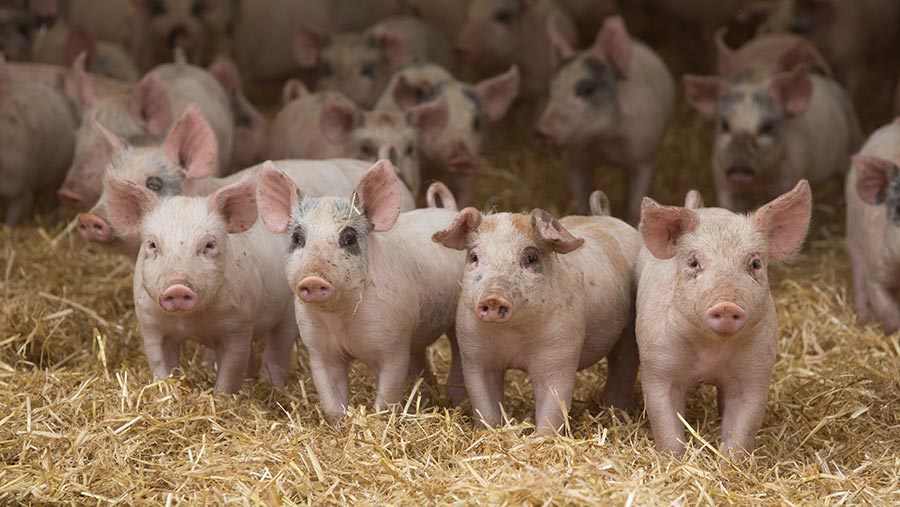Post-weaning scour in pigs – causes, signs and treatment
 © Tim Scrivener
© Tim Scrivener As if the pig sector didn’t need another challenge, the incoming ban of therapeutic levels of in-feed zinc is on the not-too-distant horizon.
This is of great concern to many involved in pig production for several reasons, with health and welfare chief among them.
When we talk about post-weaning diarrhoea, or scour, our main concern is E coli, although there are other causes and pathogens to bear in mind.
Zinc is currently widely used in feed to combat E coli infection, with very good effect.
See also: Expert advice on zinc alternatives as ban in pig diets looms
About the author

Max Wood is a vet at Larkmead Pig Vets. He graduated from the University of Nottingham, School of Veterinary Medicine and Science in 2012. He is interested in all aspects of large animal medicine but especially pig medicine and production and is a member of the Pig Veterinary Society.
Responsible pathogens
Post-weaning scour can be caused by several different pathogens.
Pathogenic strains of E coli use fimbriae to adhere to the cells lining the small intestine. K88 and F4 are the most frequently diagnosed.
These secrete an enterotoxin which causes loss of chloride ions into the gut. The gut then draws in water, leading to diarrhoea.
Non-pathogenic strains of E coli can also be found, by coincidence, in scouring pigs, but cause no disease.
Rotavirus replicates within the cells in the wall of the small intestine, causing damage, particularly to the villi, which results in diarrhoea.
Other pathogens that may be involved include bacteria such as campylobacter and salmonella. Protozoan parasite cryptosporidium may also contribute.
It is worth noting that while the pathogenic strains of E coli will not cause disease in humans, the salmonella and campylobacters may do so. Practise stringent hygiene in the face of an outbreak.
Weaning
Weaning is arguably the most stressful time in a slaughter pig’s life. The changes that occur at this time are so numerous and challenging, it is unsurprising that we see a number of problems crop up at this stage. These include:
Diet
This changes as milk is withdrawn and more hard or wet feed is introduced. Inevitably there will be more undigested food in the gut and, as the antibodies in the milk have also been removed, the levels of pathogenic E coli can rise and cause diarrhoea.
Environment
Living conditions and management of the pig change hugely at weaning. Changes such as different feeding and drinking arrangements, the absence of the dam and going from a litter to a large group – where a hierarchy must be established – all induce stress.
Stress reduces the immunity of the pig and its ability to fight infection. Pathogens can then proliferate and cause scour.
Mode of transmission
Mixing pigs at weaning provides an opportunity for E coli bacteria to spread throughout a more susceptible population. Sick pigs that have recovered in a hospital pen are sometimes a source of infection.
The organism survives well in the environment, so spread can occur indirectly if cleaning and disinfection is not up to scratch. Clothing may also be a source of spread.
The other pathogens mentioned spread in similar ways.
Clinical signs
Post-weaning diarrhoea usually occurs within four to five days or alongside a dietary change. The diarrhoea is usually grey or brown and watery. Blood is rarely present.
The condition generally resolves within three to five days, but it may persist, causing deaths from dehydration or septicaemia.
Fever can occur during a period of four or five days of illness and pigs may lack appetite and be depressed.
Recovered pigs are often stunted with chronic enteritis (inflammation of the intestine).
Inspection of faeces can be difficult in some accommodation types, so affected animals may be identified by their appearance, with dehydration and perineal staining evident.
Morbidity is high, with up to 50% of animals being affected, although mortality is generally about 10%.
The chronic effects reduce the liveweight gain of the remainder of the affected group, which is where the disease becomes extremely costly.
Laboratory analysis of faeces and intestinal contents will confirm E coli or identify another causal agent.
Treatment and prevention
Zinc oxide reduces post-weaning diarrhoea when incorporated in post-weaning rations, at levels of 3.2kg/t to give 2,600 parts/million zinc in the ration for two weeks.
However, with the feeding of zinc to pigs due to be banned in the UK from June to align with EU regulations, we must look at maximising what we already do and explore alternatives.
Management at weaning
Weaning a strong pig is a very good start, so ensure other diseases are well controlled and farrowing management is reviewed. To best prepare the gut and the animal for weaning, creep feeding is a very useful tool.
Undigested food and an immunocompromised pig allow for bacteria proliferation. Keep the same diet before and after weaning to maximise intake, and choose the most digestible diet possible.
Consider reducing protein levels slightly and using totally digestible diets.
Antibiotics
In the face of an outbreak, E coli is sensitive to a range of antibiotics. Laboratory tests will indicate which will be most effective. Antibiotics can be given in water, in feed or by injection.
Ensure you follow your veterinary instruction, particularly on the duration of treatment. Sick piglets should be treated promptly, kept warm and supported with rehydration.
Antibiotics therapy may be appropriate when given during the risk period, but must be done in discussion with your vet. Vaccinations are available, but do not offer protection against all strains.
Environment
Cleaning and disinfecting are crucial to disease control. Maintaining an even temperature for the first week after weaning can also make a significant difference.
Supplements
Feed companies have developed some additives, which work in a range of different ways and may be of some benefit on some farms.

